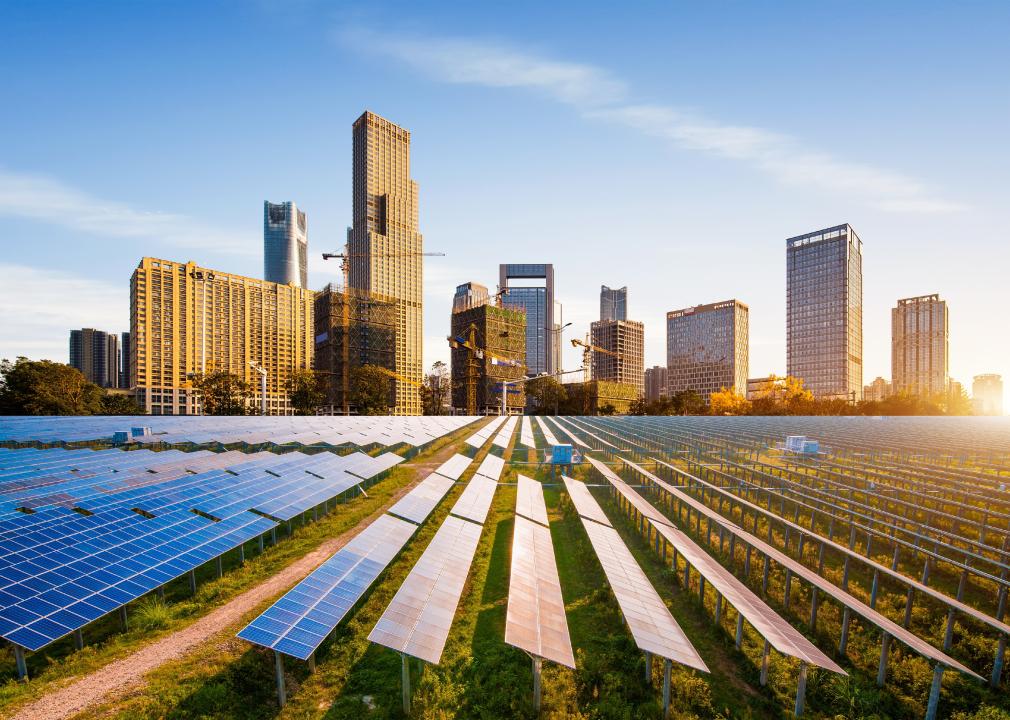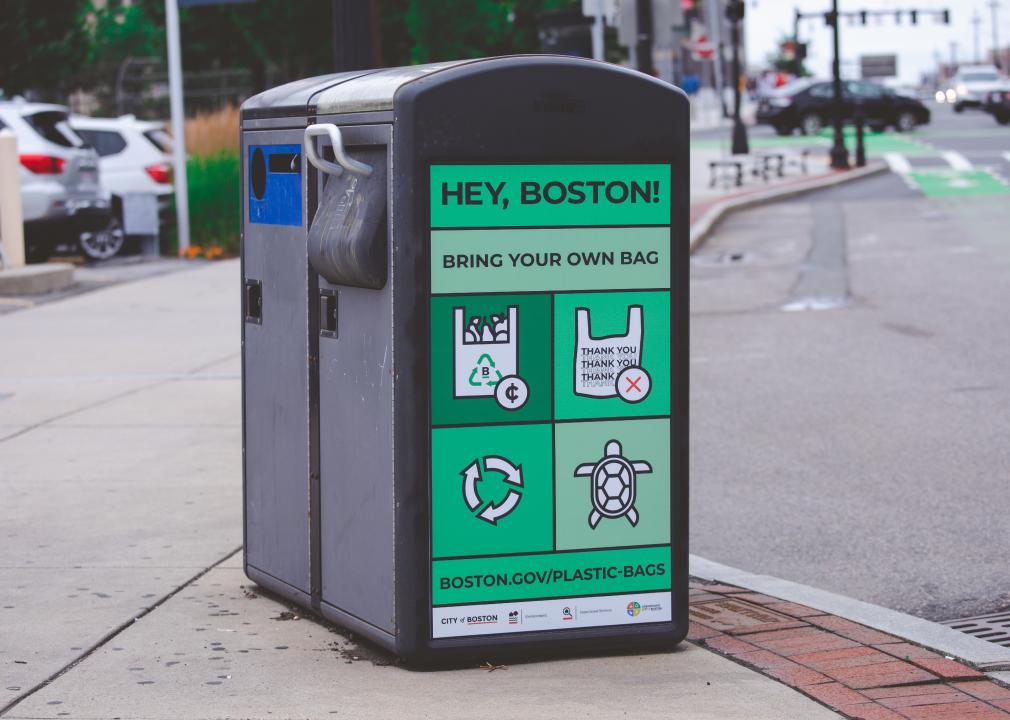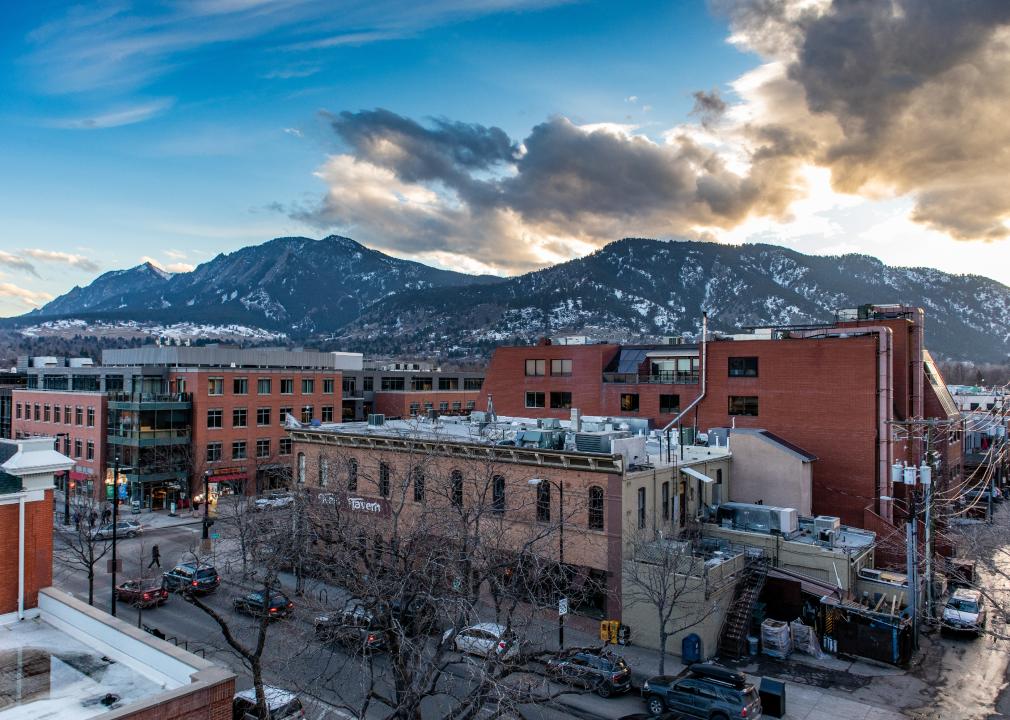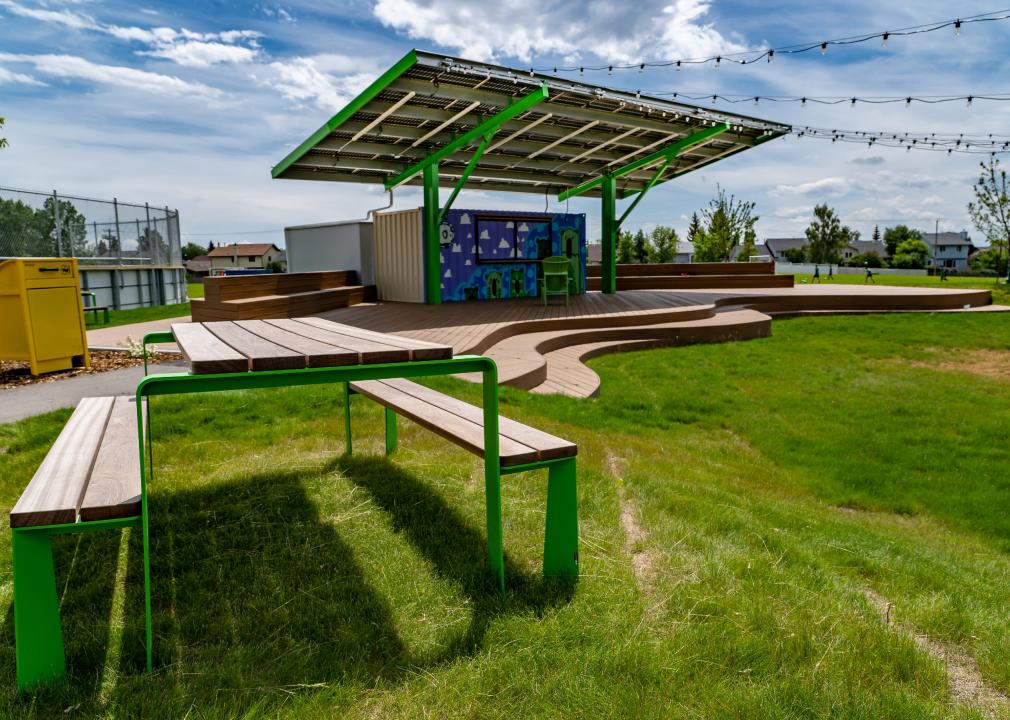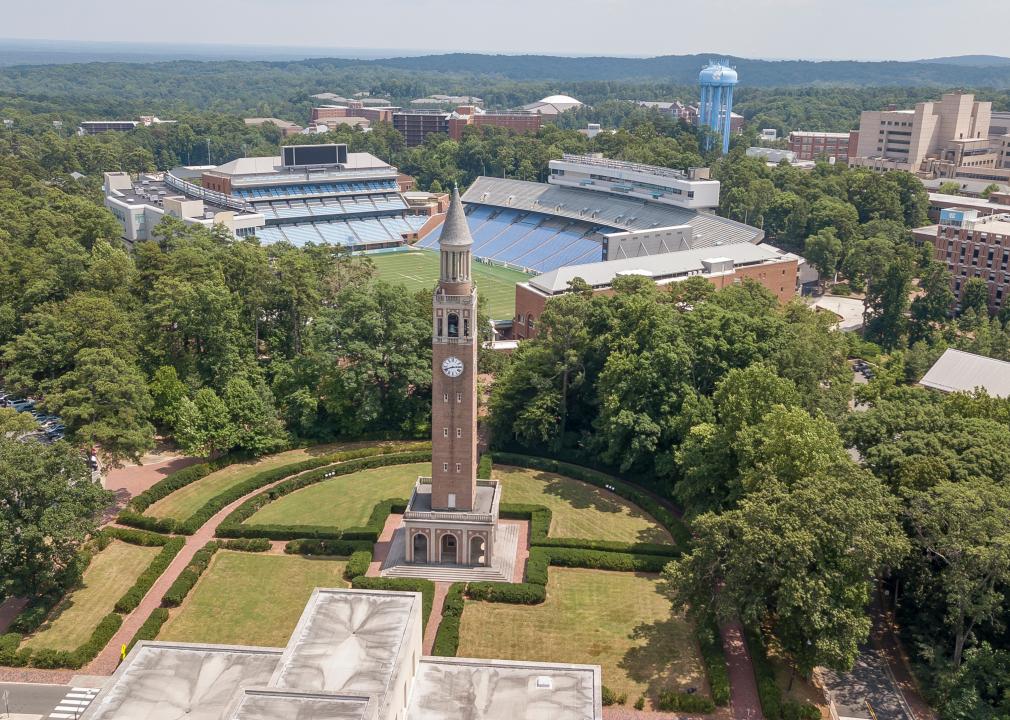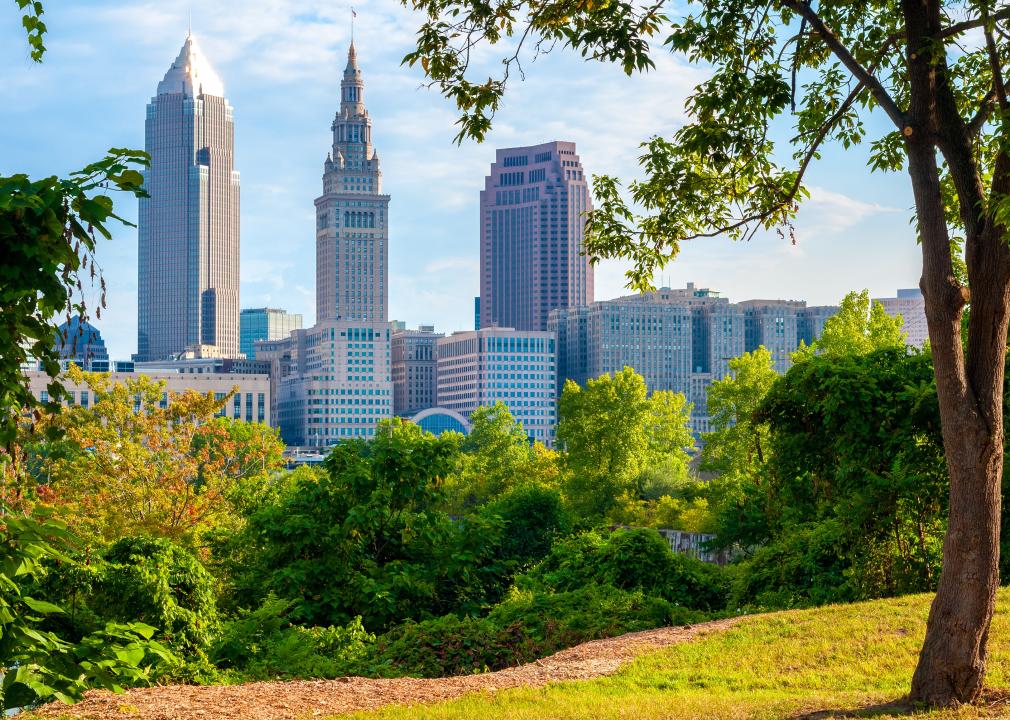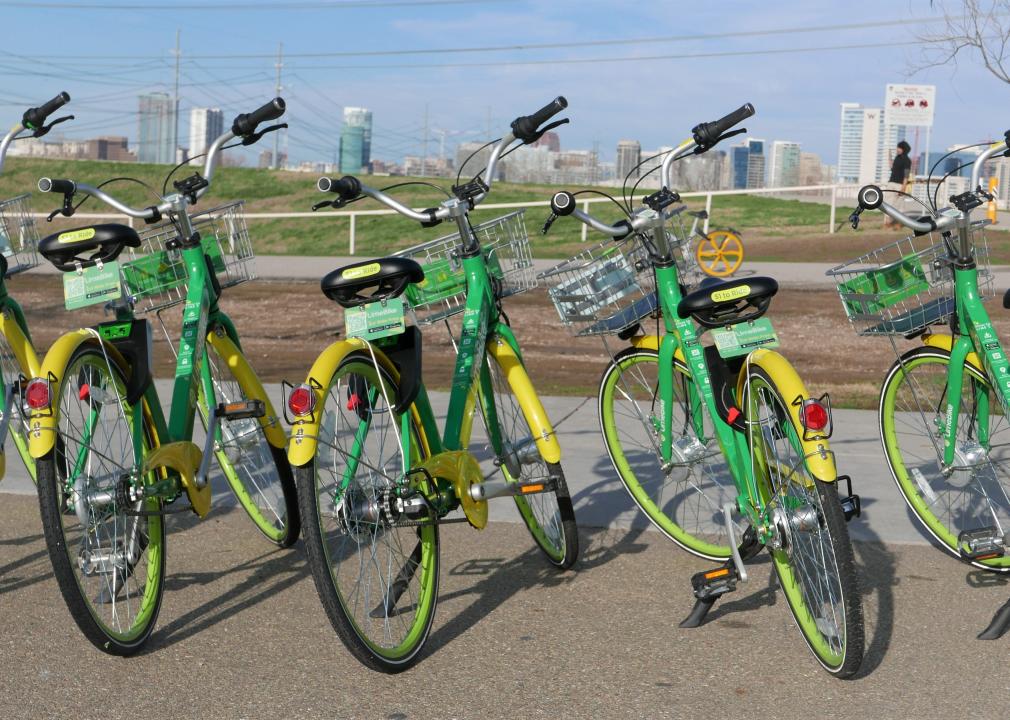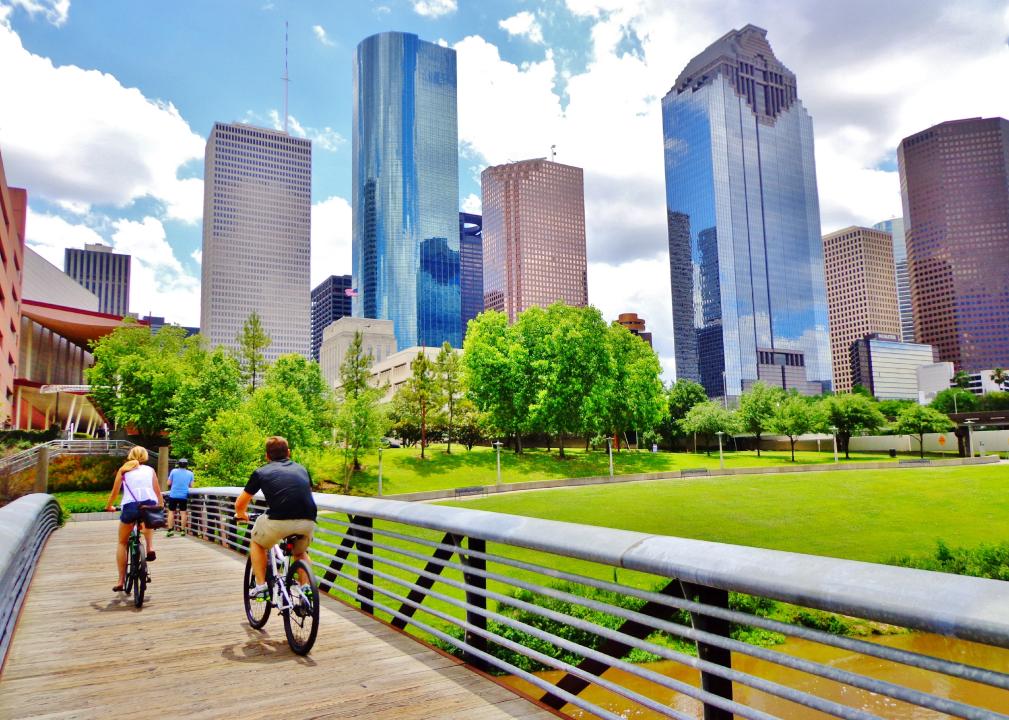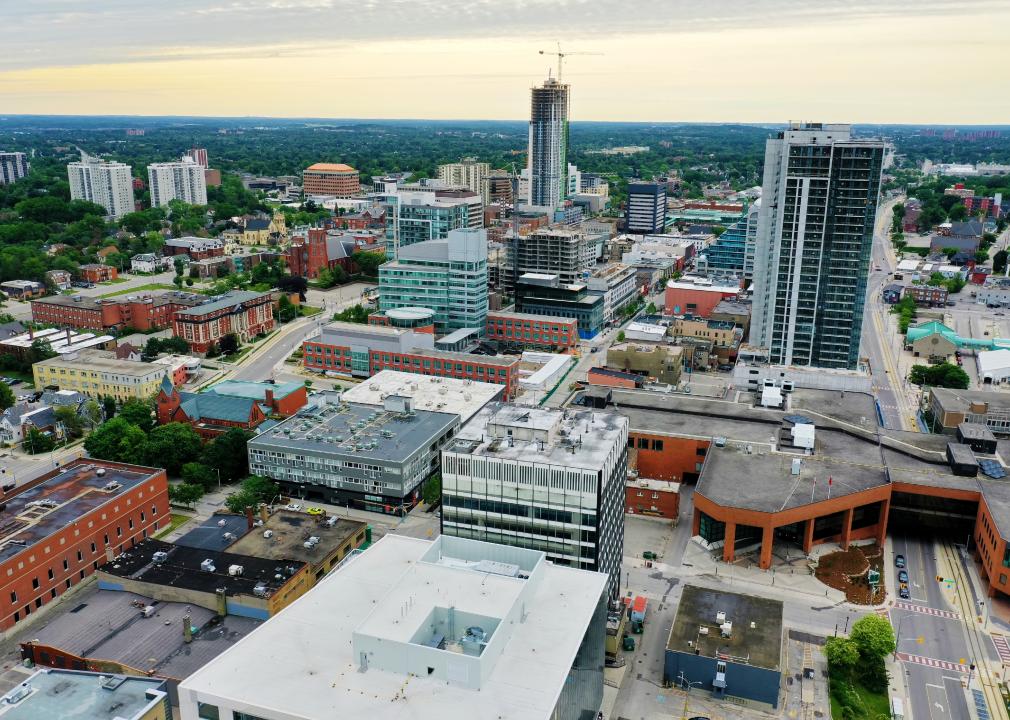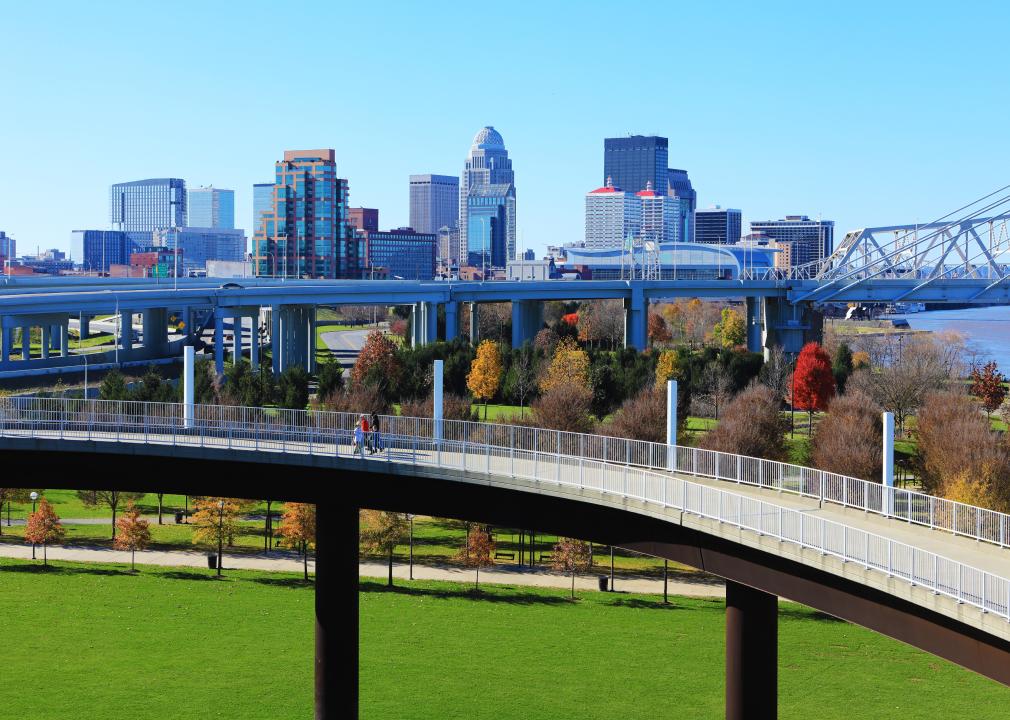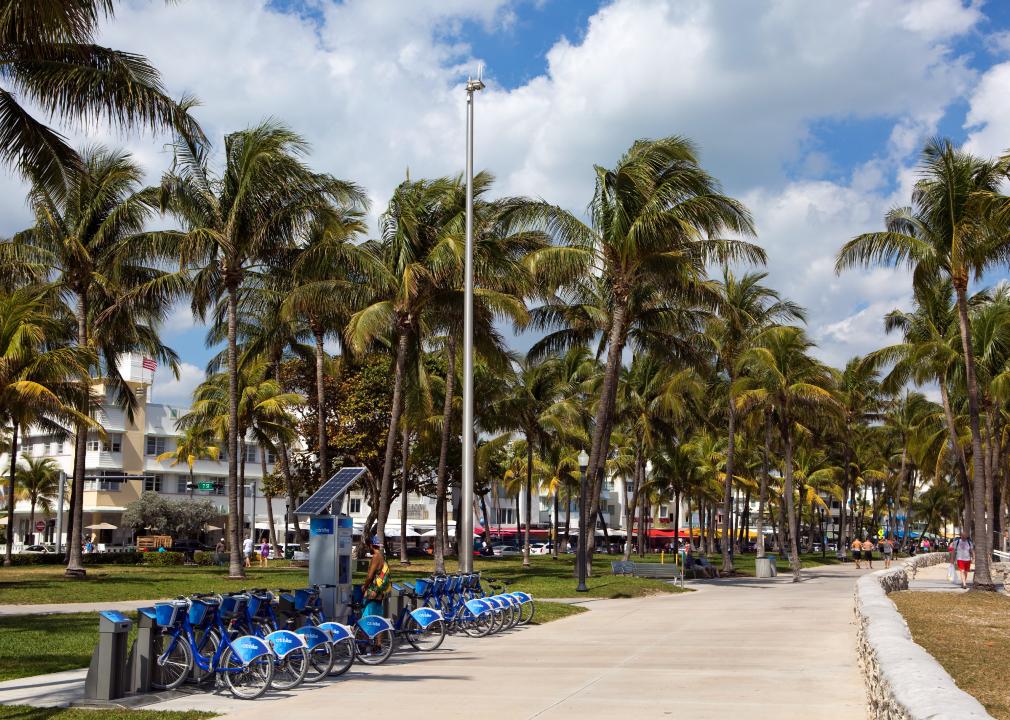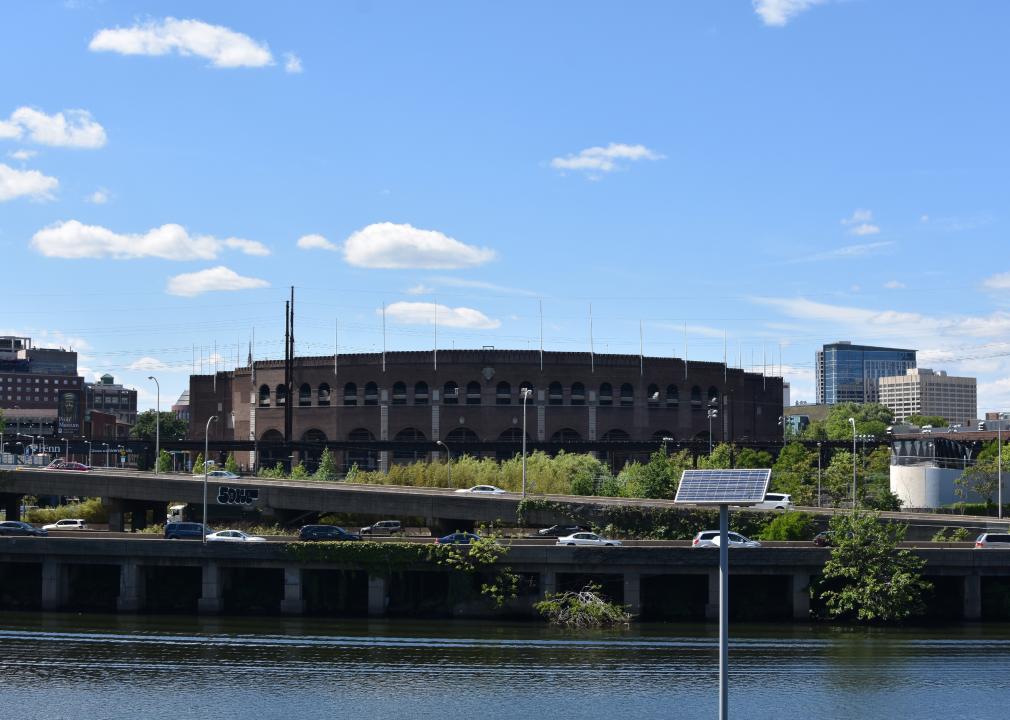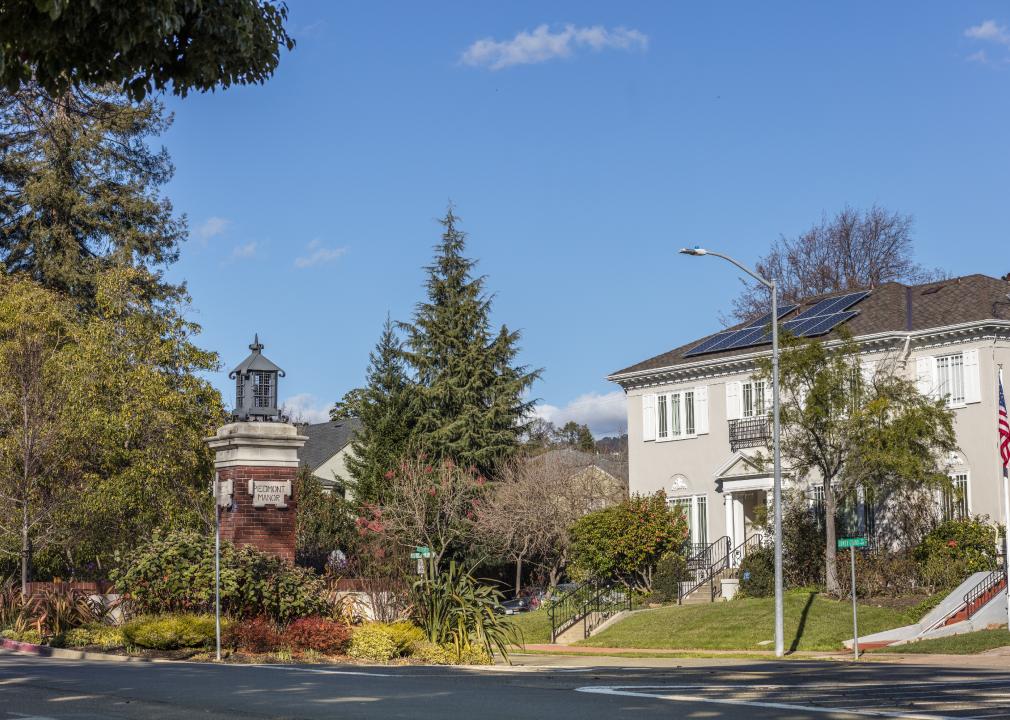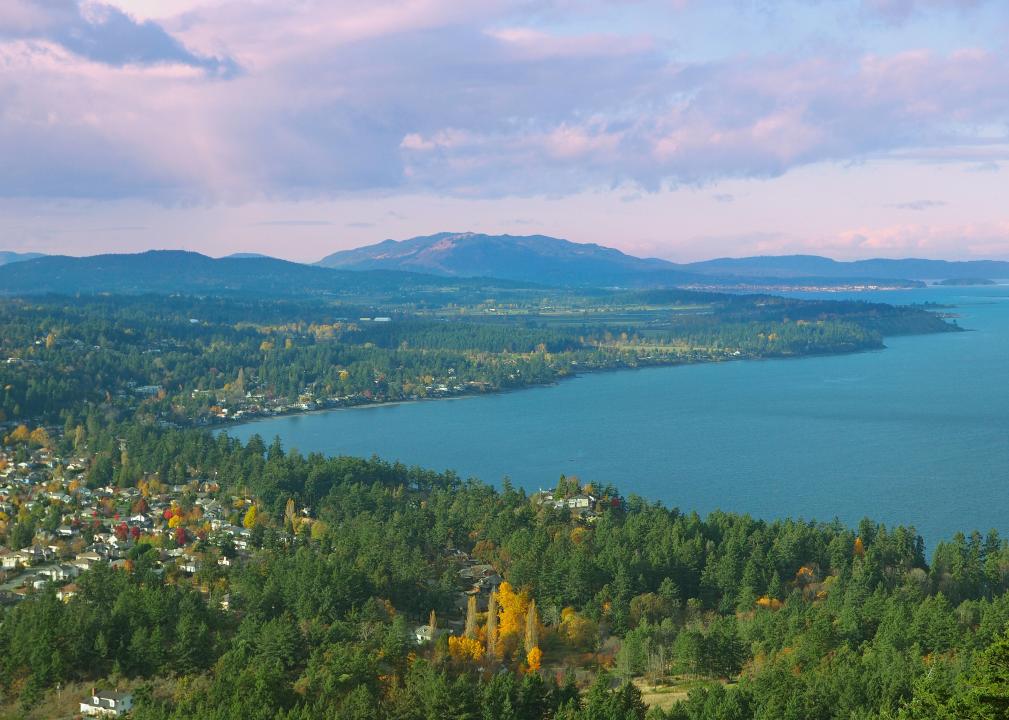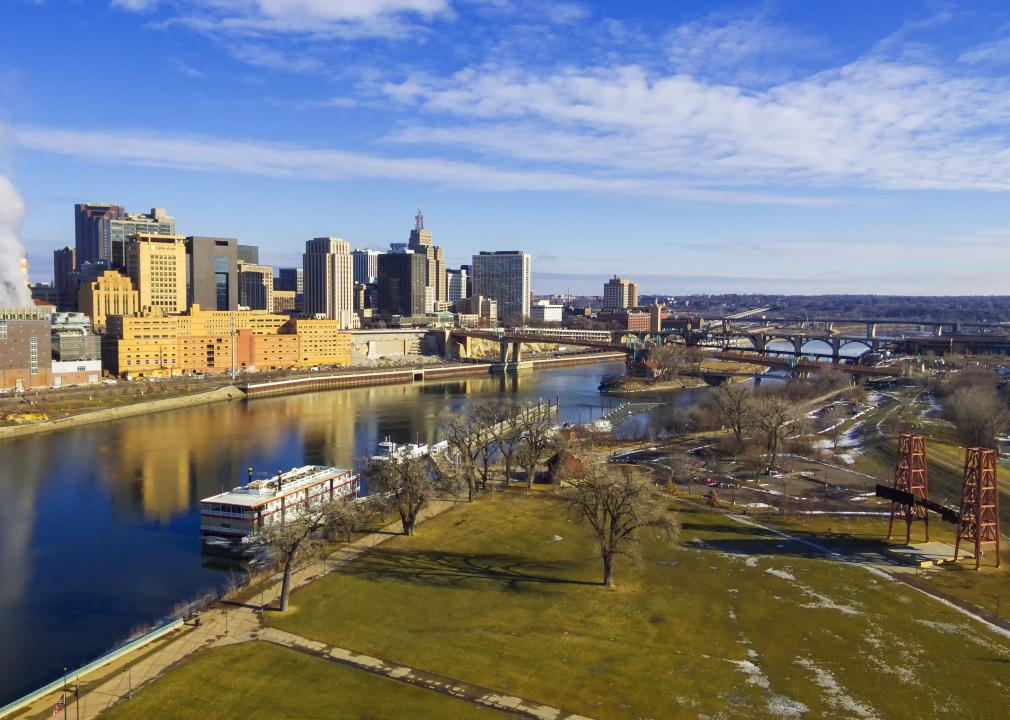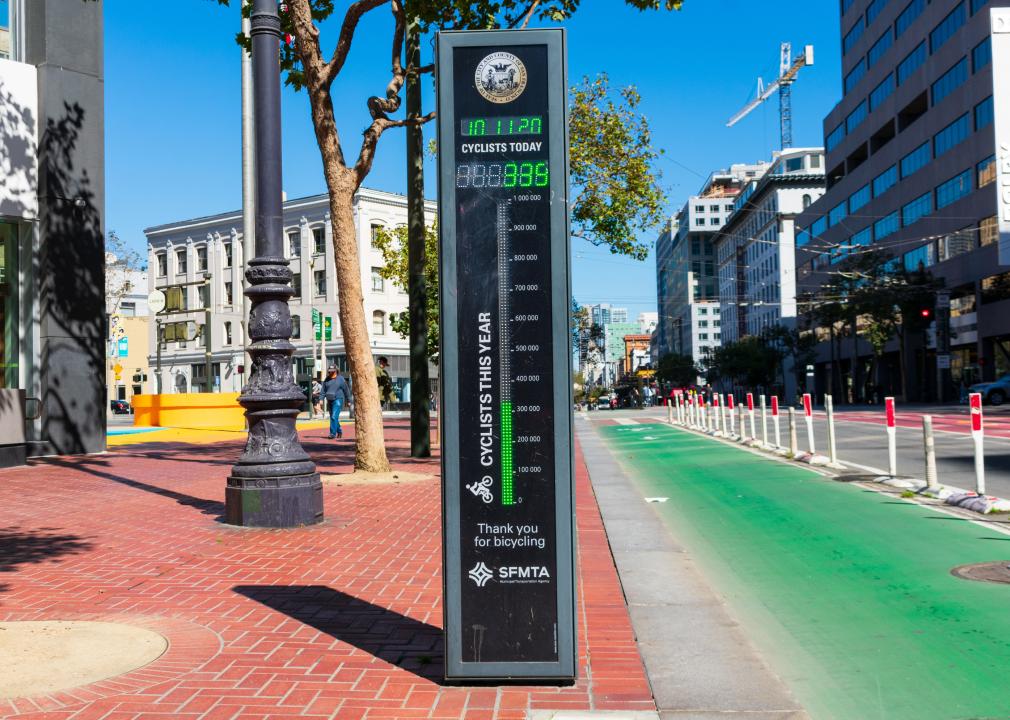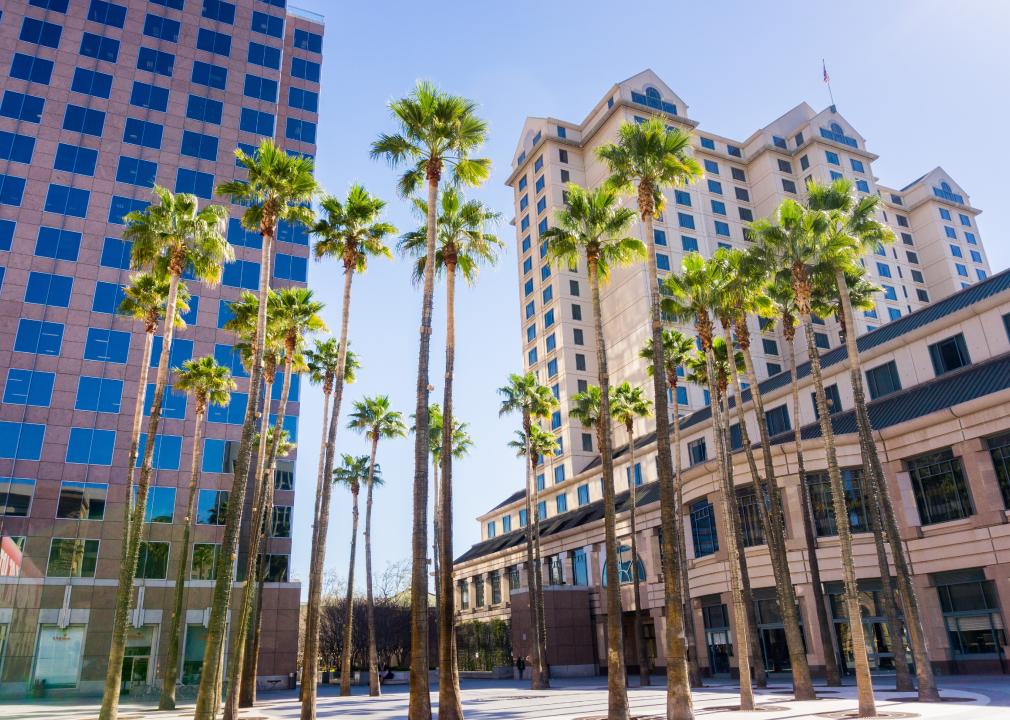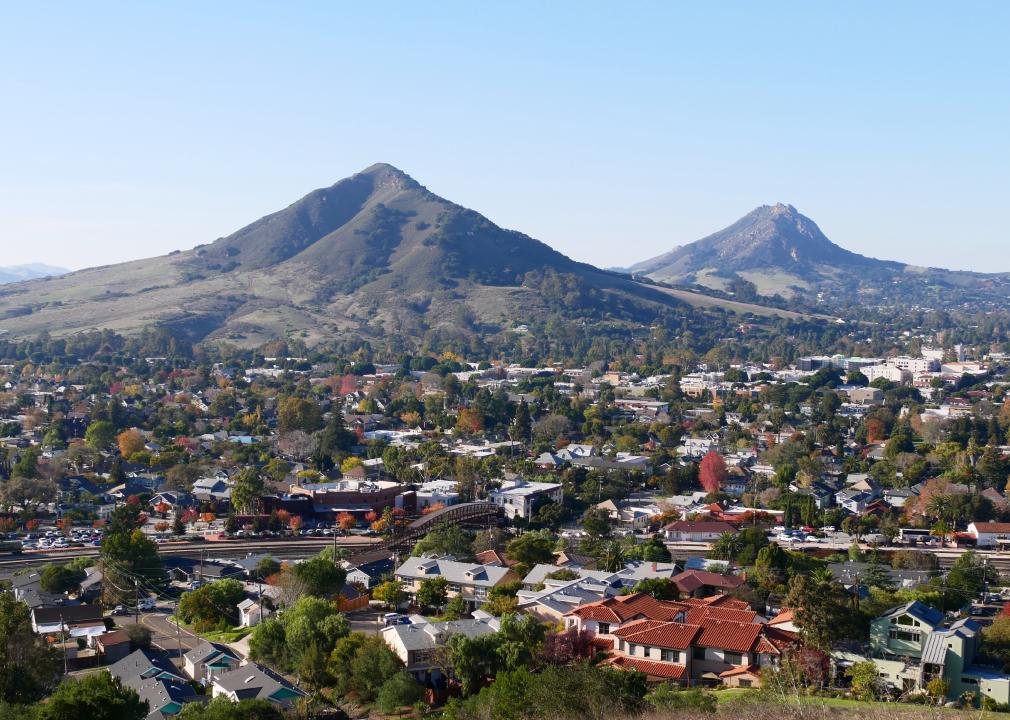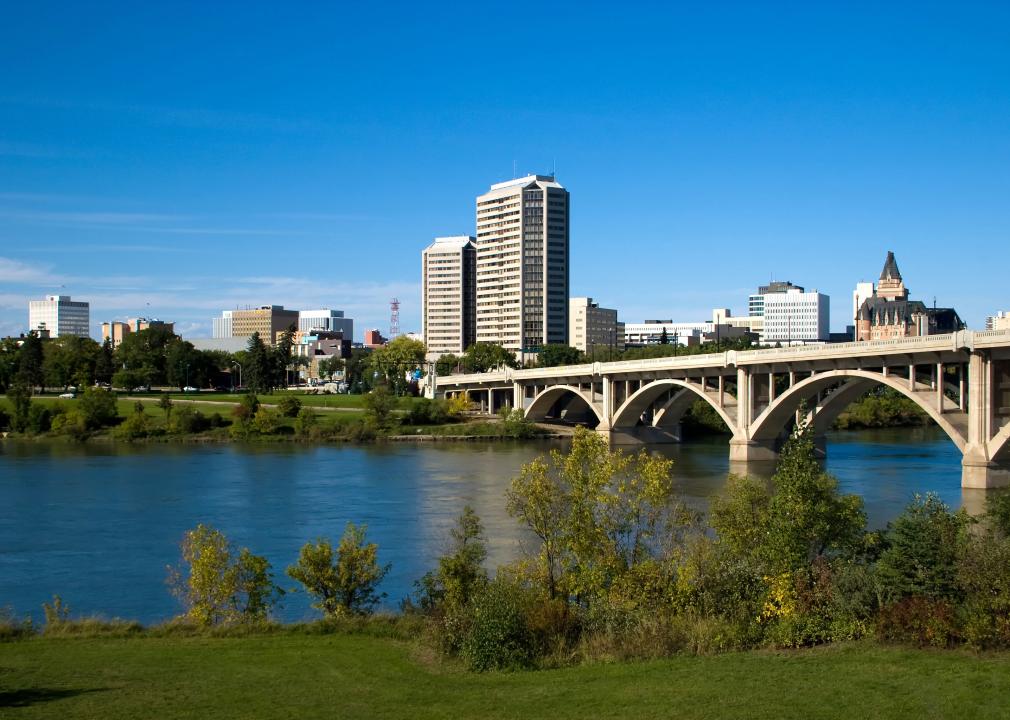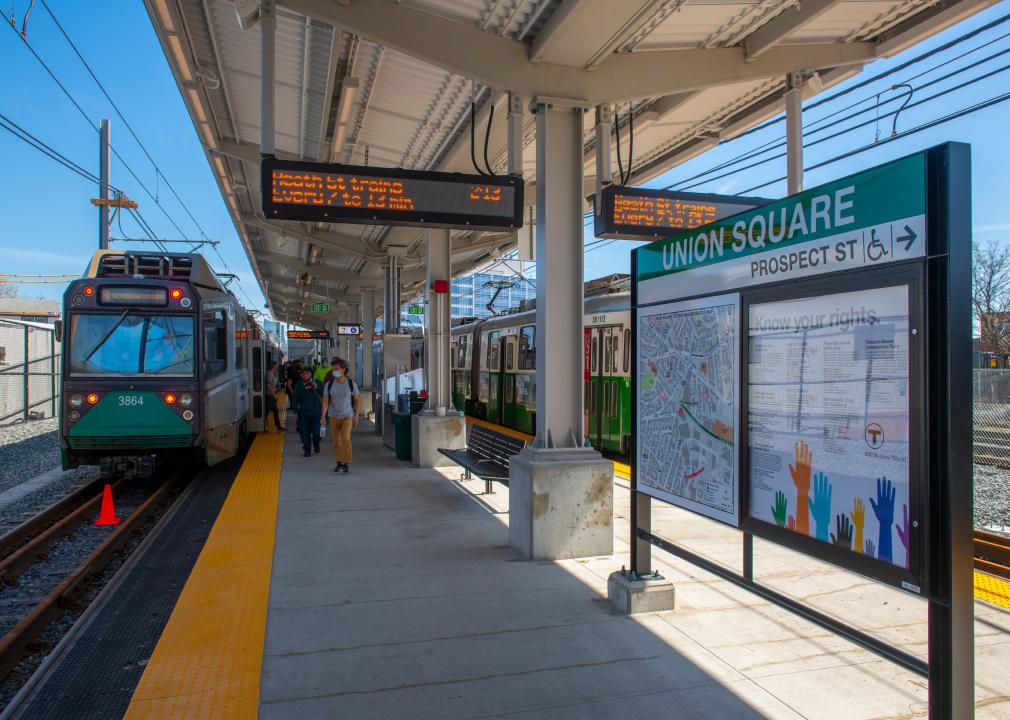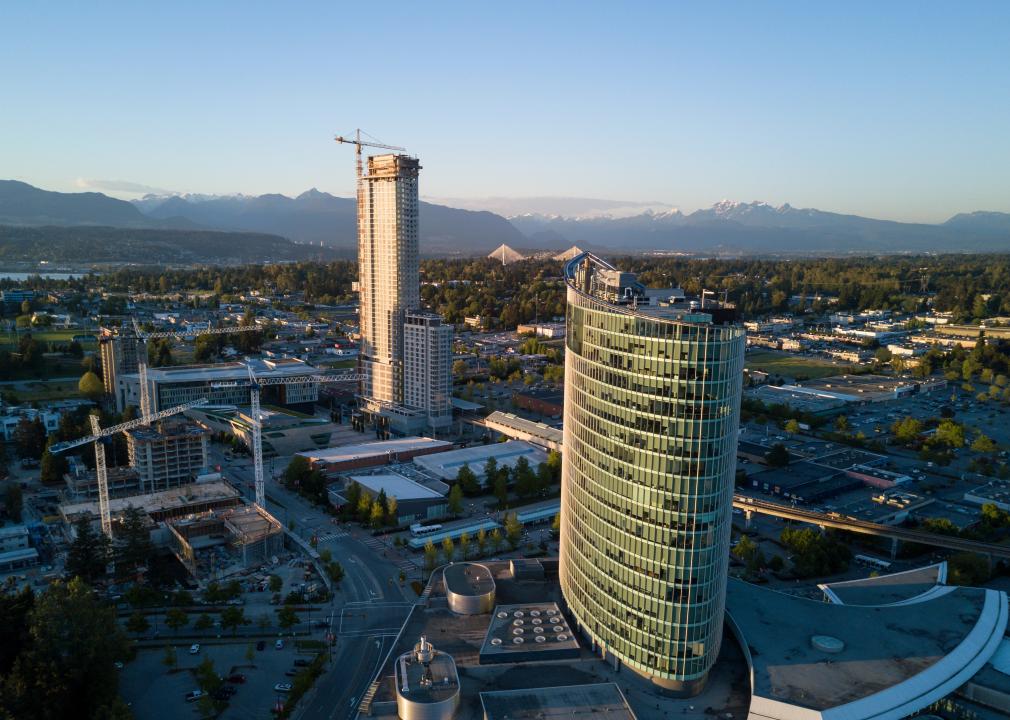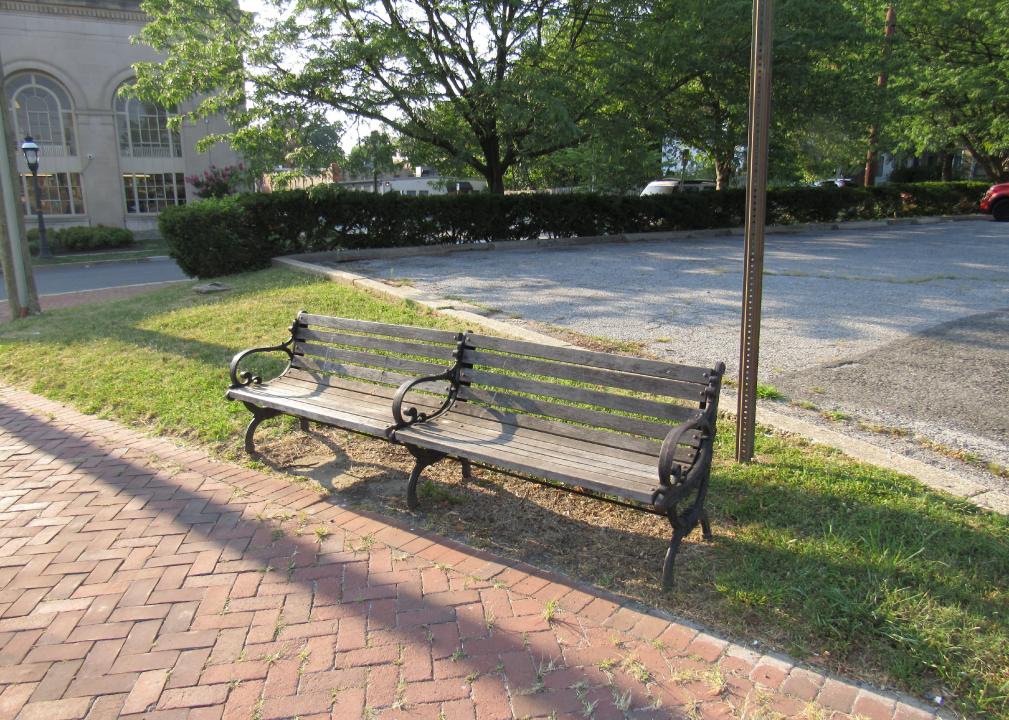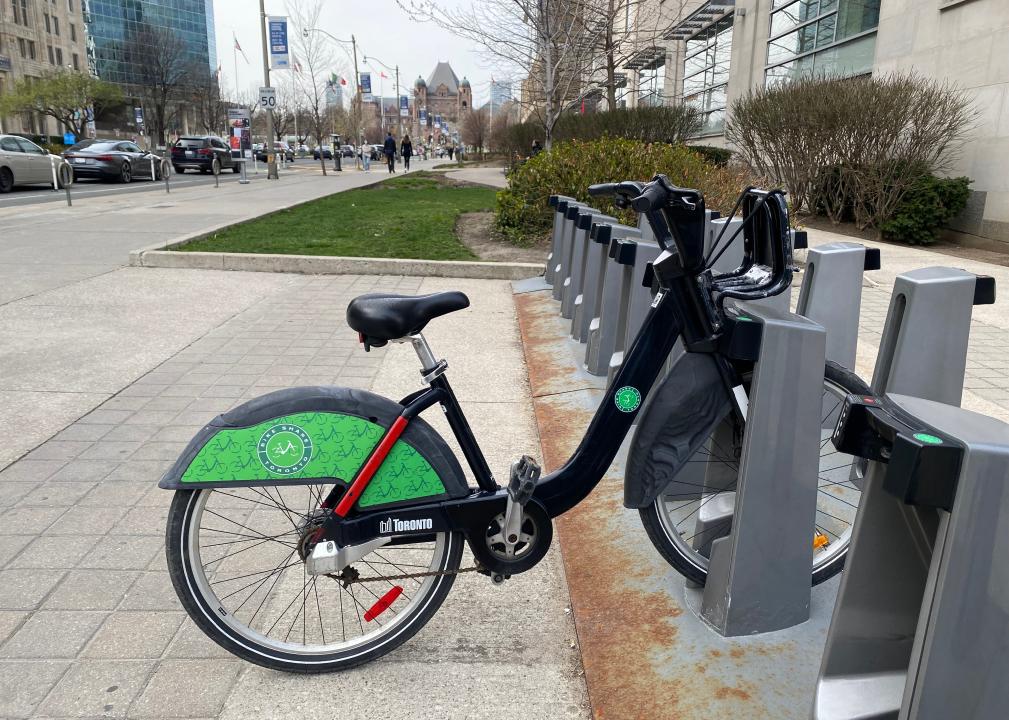The 38 greenest cities in North America
Wang An Qi // Shutterstock
The 38 greenest cities in North America
Solar power plant with skyline in background
Greening a city isn’t just good press. According to the U.S. Federal Emergency Management Agency, a more climate-conscious city supports economic growth by creating jobs, increasing property values, and improving public health factors such as better disease outcomes. By committing to improving air and water quality, cities can reduce their residents’ exposure to harmful pollutants. Designing more green spaces can welcome cooler summers, reduce the risk of heat-related illness; and bring forth additional recreation spaces to the community, increasing opportunities for both physical activity and social engagement.
In its June 2021 report on building resilient nature-based local communities, FEMA reported that Los Angeles added more than 2,000 jobs due to a $166 million investment in nature-based solutions from 2012 to 2014. Such greening investments have demonstrated immediate and long-term benefits to the environment and populace alike. Another notable example from Massachusetts showed that, rather than build a costly treatment facility for the Quabbin and Wachusett Reservoirs, the Massachusetts Water Resources Authority instead invested $130 million on nature-based solutions to protect the more than 20,000 acres of watershed that drain into the reservoirs. The move saved an estimated $4 million per year on maintenance costs for a treatment facility and kept local drinking water clean in the bargain.
Nature-based solutions are defined as sustainable planning, design, environmental management, and engineering practices that weave natural features or processes into the built environment. These solutions promote adaptation and resilience, enlist natural solutions to combat climate change, reduce flood risks, restore and protect wetlands, and more.
So which cities are prioritizing policies toward a healthier and more sustainable environment? Calgary.com compiled a list of the greenest cities in North America according to the Carbon Disclosure Project, an international nonprofit that tracks the environmental impact of companies and municipalities around the world. The cities in this list were part of the CDP’s 2021 A List, an annual ranking of cities based on their climate initiatives. They include two districts (Washington, D.C. and the district of Saanich, British Columbia) and are listed in alphabetical order.
To make the list, each city must have a publicly available climate action plan, including emissions reduction and renewable energy targets. The cities were also required to complete climate risk and vulnerability assessments and show measured progress toward achieving their goals. More than 1,000 cities worldwide report to the CDP, 95 of which made the A List. The following are the greenest.
![]()
Paul Brady Photography // Shutterstock
Ann Arbor, Michigan
Historic Michigan Theater in Downtown, Ann Arbor
– Energy breakdown:
— Coal: 49.7%
— Gas: 17.2%
— Oil: 0.3%
— Nuclear: 21.1%
— Hydro: 0.3%
— Bioenergy (biomass and biofuels): 1.4%
— Wind: 9.8%
— Geothermal: 0.0%
— Solar (photovoltaic and thermal): 0.0%
— Waste to energy (excluding biomass component): 0.3%
2p2play // Shutterstock
Boston, Massachusetts
Recycling bins and trash can in Boston, Massachusetts
– Energy breakdown:
— Coal: 0.4%
— Gas: 39.0%
— Oil: 0.3%
— Nuclear: 25.0%
— Hydro: 7.0%
— Bioenergy (biomass and biofuels): 6.0%
— Wind: 3.0%
— Geothermal: 0.0%
— Solar (photovoltaic and thermal): 0.0%
— Waste to energy (excluding biomass component): 0.0%
MIRAJA DESIGN // Shutterstock
Boulder, Colorado
Aerial View Of Boulder, Colorado
– Energy breakdown:
— Coal: 33.0%
— Gas: 37.0%
— Oil: 0.0%
— Nuclear: 0.0%
— Hydro: 1.0%
— Bioenergy (biomass and biofuels): 0.0%
— Wind: 25.0%
— Geothermal: 0.0%
— Solar (photovoltaic and thermal): 0.0%
— Waste to energy (excluding biomass component): 4.0%
Ramon Cliff // Shutterstock
Calgary, Alberta
Solar rooftop amphitheater with composite decking and picnic tables at a public park
– Energy breakdown:
— Coal: 36.0%
— Gas: 48.0%
— Oil: 0.0%
— Nuclear: 0.0%
— Hydro: 6.0%
— Bioenergy (biomass and biofuels): 0.0%
— Wind: 9.0%
— Geothermal: 0.0%
— Solar (photovoltaic and thermal): 0.0%
— Waste to energy (excluding biomass component): 0.0%
Grindstone Media Group // Shutterstock
Chapel Hill, North Carolina
Kenan Memorial Stadium in Chapel Hill
– Energy breakdown:
— Coal: 22.0%
— Gas: 39.0%
— Oil: 0.0%
— Nuclear: 37.0%
— Hydro: 0.5%
— Bioenergy (biomass and biofuels): 0.0%
— Wind: 0.5%
— Geothermal: 0.0%
— Solar (photovoltaic and thermal): 0.0%
— Waste to energy (excluding biomass component): 1.0%
Agnieszka Gaul // Shutterstock
Cincinnati, Ohio
Cincinnati, Ohio skyline with John Roebling bridge
– Energy breakdown:
— Coal: 49.8%
— Gas: 16.7%
— Oil: 0.4%
— Nuclear: 27.6%
— Hydro: 0.9%
— Bioenergy (biomass and biofuels): 0.6%
— Wind: 3.2%
— Geothermal: 0.0%
— Solar (photovoltaic and thermal): 0.0%
— Waste to energy (excluding biomass component): 0.1%
Kenneth Sponsler // Shutterstock
Cleveland, Ohio
Cleveland, Ohio, in morning light framed by trees in a small park
– Energy breakdown:
— Coal: 34.9%
— Gas: 25.3%
— Oil: 0.0%
— Nuclear: 30.5%
— Hydro: 5.7%
— Bioenergy (biomass and biofuels): 0.4%
— Wind: 2.3%
— Geothermal: 0.0%
— Solar (photovoltaic and thermal): 0.0%
— Waste to energy (excluding biomass component): 0.0%
Dorti // Shutterstock
Dallas, Texas
LimeBike parked in a row in Dallas
– Energy breakdown:
— Coal: 18.0%
— Gas: 45.7%
— Oil: 0.0%
— Nuclear: 11.0%
— Hydro: 0.2%
— Bioenergy (biomass and biofuels): 0.1%
— Wind: 23.0%
— Geothermal: 0.0%
— Solar (photovoltaic and thermal): 0.0%
— Waste to energy (excluding biomass component): 2.0%
DBSOCAL // Shutterstock
Encinitas, California
Encinitas sign and trees
– Energy breakdown:
— Coal: 0.0%
— Gas: 54.0%
— Oil: 0.0%
— Nuclear: 0.0%
— Hydro: 0.0%
— Bioenergy (biomass and biofuels): 2.0%
— Wind: 16.0%
— Geothermal: 0.0%
— Solar (photovoltaic and thermal): 0.0%
— Waste to energy (excluding biomass component): 18.0%
shuttersv // Shutterstock
Fayetteville, Arkansas
Fayetteville tourist visitor information center storefront view
– Energy breakdown:
— Coal: 22.3%
— Gas: 44.2%
— Oil: 1.1%
— Nuclear: 0.0%
— Hydro: 5.0%
— Bioenergy (biomass and biofuels): 1.5%
— Wind: 25.1%
— Geothermal: 0.0%
— Solar (photovoltaic and thermal): 0.0%
— Waste to energy (excluding biomass component): 0.4%
Real Window Creative // Shutterstock
Flagstaff, Arizona
Traffic and the train station on Route 66 in Flagstaff, Arizona
– Energy breakdown:
— Coal: 20.8%
— Gas: 35.0%
— Oil: 0.0%
— Nuclear: 29.2%
— Hydro: 0.0%
— Bioenergy (biomass and biofuels): 0.5%
— Wind: 1.7%
— Geothermal: 0.3%
— Solar (photovoltaic and thermal): 0.3%
— Waste to energy (excluding biomass component): 12.2%
Page Light Studios // Shutterstock
Fort Collins, Colorado
Eagle statue and fountain in Fort Collins
– Energy breakdown:
— Coal: 64.2%
— Gas: 0.0%
— Oil: 0.0%
— Nuclear: 0.0%
— Hydro: 19.3%
— Bioenergy (biomass and biofuels): 0.0%
— Wind: 11.8%
— Geothermal: 0.0%
— Solar (photovoltaic and thermal): 0.0%
— Waste to energy (excluding biomass component): 0.6%
John Roche // Shutterstock
Fremont, California
Sunset over an empty road and store fronts
– Energy breakdown:
— Coal: 0.0%
— Gas: 0.0%
— Oil: 0.0%
— Nuclear: 1.0%
— Hydro: 30.0%
— Bioenergy (biomass and biofuels): 4.0%
— Wind: 36.0%
— Geothermal: 12.0%
— Solar (photovoltaic and thermal): 12.0%
— Waste to energy (excluding biomass component): 4.0%
SnapASkyline // Shutterstock
Hayward, California
Hayward water tower in the evening from above
– Energy breakdown:
— Coal: 0.0%
— Gas: 0.0%
— Oil: 0.0%
— Nuclear: 0.0%
— Hydro: 25.0%
— Bioenergy (biomass and biofuels): 0.0%
— Wind: 37.0%
— Geothermal: 0.0%
— Solar (photovoltaic and thermal): 0.0%
— Waste to energy (excluding biomass component): 38.0%
Nate Hovee // Shutterstock
Houston, Texas
Bicyclists cross wooden bridge in Buffalo Bayou Park
– Energy breakdown:
— Coal: 18.6%
— Gas: 51.1%
— Oil: 0.0%
— Nuclear: 9.9%
— Hydro: 0.3%
— Bioenergy (biomass and biofuels): 0.2%
— Wind: 18.3%
— Geothermal: 0.0%
— Solar (photovoltaic and thermal): 0.0%
— Waste to energy (excluding biomass component): 1.0%
Sean Pavone // Shutterstock
Indianapolis, Indiana
Indiana State Capitol Building in Indianapolis
– Energy breakdown:
— Coal: 43.0%
— Gas: 45.0%
— Oil: 2.0%
— Nuclear: 0.0%
— Hydro: 0.0%
— Bioenergy (biomass and biofuels): 0.0%
— Wind: 8.0%
— Geothermal: 0.0%
— Solar (photovoltaic and thermal): 0.0%
— Waste to energy (excluding biomass component): 2.0%
Suzanne Tucker // Shutterstock
Iowa City, Iowa
Old Capitol building downtown Iowa City
– Energy breakdown:
— Coal: 45.3%
— Gas: 2.1%
— Oil: 0.0%
— Nuclear: 13.0%
— Hydro: 0.0%
— Bioenergy (biomass and biofuels): 0.2%
— Wind: 39.4%
— Geothermal: 0.0%
— Solar (photovoltaic and thermal): 0.0%
— Waste to energy (excluding biomass component): 0.0%
Harold Stiver // Shutterstock
Kitchener, Ontario
An aerial view of Kitchener, Ontario, Canada
– Energy breakdown:
— Coal: 0.0%
— Gas: 6.1%
— Oil: 0.0%
— Nuclear: 58.2%
— Hydro: 24.0%
— Bioenergy (biomass and biofuels): 0.5%
— Wind: 8.2%
— Geothermal: 0.0%
— Solar (photovoltaic and thermal): 0.0%
— Waste to energy (excluding biomass component): 2.4%
Keith J Finks // Shutterstock
Lexington, Massachusetts
A white fence and colonial home in Lexington, MA
– Energy breakdown:
— Coal: 0.0%
— Gas: 0.0%
— Oil: 0.0%
— Nuclear: 0.0%
— Hydro: 0.0%
— Bioenergy (biomass and biofuels): 0.0%
— Wind: 94.6%
— Geothermal: 0.0%
— Solar (photovoltaic and thermal): 0.0%
— Waste to energy (excluding biomass component): 5.4%
Juan Llauro // Shutterstock
Los Angeles, California
A Metro bike station in Los Angeles
– Energy breakdown:
— Coal: 21.0%
— Gas: 27.0%
— Oil: 0.0%
— Nuclear: 14.0%
— Hydro: 6.0%
— Bioenergy (biomass and biofuels): 0.0%
— Wind: 10.0%
— Geothermal: 9.0%
— Solar (photovoltaic and thermal): 9.0%
— Waste to energy (excluding biomass component): 12.0%
Harold Stiver // Shutterstock
Louisville, Kentucky
The Louisville, Kentucky skyline with pedestrian walkway in front
– Energy breakdown:
— Coal: 60.0%
— Gas: 37.0%
— Oil: 0.0%
— Nuclear: 0.0%
— Hydro: 3.0%
— Bioenergy (biomass and biofuels): 0.0%
— Wind: 0.0%
— Geothermal: 0.0%
— Solar (photovoltaic and thermal): 0.0%
— Waste to energy (excluding biomass component): 0.0%
Steven Frame // Shutterstock
Miami, Florida
Man uses a self-service kiosk station to rent a bicycle on Ocean Drive in Miami Beach
– Energy breakdown:
— Coal: 2.1%
— Gas: 72.3%
— Oil: 0.3%
— Nuclear: 22.3%
— Hydro: 0.0%
— Bioenergy (biomass and biofuels): 0.0%
— Wind: 0.0%
— Geothermal: 0.0%
— Solar (photovoltaic and thermal): 0.0%
— Waste to energy (excluding biomass component): 1.5%
Robert Vincelli // Shutterstock
Philadelphia, Pennsylvania
American coliseum in Philadelphia with solar panel
– Energy breakdown:
— Coal: 17.6%
— Gas: 38.0%
— Oil: 0.2%
— Nuclear: 39.7%
— Hydro: 0.9%
— Bioenergy (biomass and biofuels): 1.9%
— Wind: 1.0%
— Geothermal: 0.0%
— Solar (photovoltaic and thermal): 0.0%
— Waste to energy (excluding biomass component): 0.4%
BondRocketImages // Shutterstock
Piedmont, California
Piedmont neighborhood in California
– Energy breakdown:
— Coal: 0.0%
— Gas: 0.0%
— Oil: 0.0%
— Nuclear: 0.0%
— Hydro: 0.0%
— Bioenergy (biomass and biofuels): 0.0%
— Wind: 50.0%
— Geothermal: 0.0%
— Solar (photovoltaic and thermal): 0.0%
— Waste to energy (excluding biomass component): 50.0%
pr2is // Shutterstock
Saanich, British Columbia
Saanich Peninsula and Cordova Bay on Vancouver Island
– Energy breakdown:
— Coal: 0.0%
— Gas: 1.8%
— Oil: 0.0%
— Nuclear: 0.0%
— Hydro: 95.6%
— Bioenergy (biomass and biofuels): 0.0%
— Wind: 0.0%
— Geothermal: 0.0%
— Solar (photovoltaic and thermal): 0.0%
— Waste to energy (excluding biomass component): 0.0%
LAM-Photography // Shutterstock
St. Paul, Minnesota
St. Paul skyline in Minnesota
– Energy breakdown:
— Coal: 23.0%
— Gas: 23.0%
— Oil: 0.0%
— Nuclear: 28.0%
— Hydro: 6.0%
— Bioenergy (biomass and biofuels): 2.0%
— Wind: 15.0%
— Geothermal: 0.0%
— Solar (photovoltaic and thermal): 0.0%
— Waste to energy (excluding biomass component): 3.0%
Michael Vi // Shutterstock
San Francisco, California
Automated bicycle counter with display showing the daily and annual total bike ridership
– Energy breakdown:
— Coal: 0.0%
— Gas: 1.0%
— Oil: 0.0%
— Nuclear: 10.0%
— Hydro: 50.0%
— Bioenergy (biomass and biofuels): 1.0%
— Wind: 18.0%
— Geothermal: 6.0%
— Solar (photovoltaic and thermal): 6.0%
— Waste to energy (excluding biomass component): 6.0%
Sundry Photography // Shutterstock
San Jose, California
Urban landscape in downtown San Jose
– Energy breakdown:
— Coal: 0.0%
— Gas: 0.0%
— Oil: 0.0%
— Nuclear: 13.0%
— Hydro: 31.0%
— Bioenergy (biomass and biofuels): 2.0%
— Wind: 24.0%
— Geothermal: 3.0%
— Solar (photovoltaic and thermal): 3.0%
— Waste to energy (excluding biomass component): 17.0%
joojoob27 // Shutterstock
San Luis Obispo, California
Aerial view of Bishop peak and Cerro San Luis Obispo
– Energy breakdown:
— Coal: 0.0%
— Gas: 0.0%
— Oil: 0.0%
— Nuclear: 0.0%
— Hydro: 66.0%
— Bioenergy (biomass and biofuels): 0.0%
— Wind: 11.0%
— Geothermal: 12.0%
— Solar (photovoltaic and thermal): 12.0%
— Waste to energy (excluding biomass component): 11.0%
Tero Vesalainen // Shutterstock
Santa Monica, California
Santa Monica pier with solar panels
– Energy breakdown:
— Coal: 1.0%
— Gas: 10.9%
— Oil: 0.0%
— Nuclear: 2.9%
— Hydro: 5.3%
— Bioenergy (biomass and biofuels): 1.5%
— Wind: 9.4%
— Geothermal: 1.5%
— Solar (photovoltaic and thermal): 1.5%
— Waste to energy (excluding biomass component): 65.1%
Scott Prokop // Shutterstock
Saskatoon, Saskatchewan
Saskatoon cityscape on sunny day
– Energy breakdown:
— Coal: 31.0%
— Gas: 45.0%
— Oil: 0.0%
— Nuclear: 0.0%
— Hydro: 18.0%
— Bioenergy (biomass and biofuels): 0.0%
— Wind: 5.0%
— Geothermal: 0.0%
— Solar (photovoltaic and thermal): 0.0%
— Waste to energy (excluding biomass component): 0.0%
The Image Party // Shutterstock
Seattle, Washington
The bike lane of a street in downtown Seattle
– Energy breakdown:
— Coal: 0.0%
— Gas: 0.0%
— Oil: 0.0%
— Nuclear: 5.0%
— Hydro: 84.0%
— Bioenergy (biomass and biofuels): 1.0%
— Wind: 4.0%
— Geothermal: 0.0%
— Solar (photovoltaic and thermal): 0.0%
— Waste to energy (excluding biomass component): 0.0%
Wangkun Jia // Shutterstock
Somerville, Massachusetts
Union Square station at Union Square in city of Somerville, Massachusetts
– Energy breakdown:
— Coal: 0.5%
— Gas: 48.5%
— Oil: 0.2%
— Nuclear: 30.5%
— Hydro: 8.9%
— Bioenergy (biomass and biofuels): 2.5%
— Wind: 3.6%
— Geothermal: 0.0%
— Solar (photovoltaic and thermal): 0.0%
— Waste to energy (excluding biomass component): 1.7%
EB Adventure Photography // Shutterstock
Surrey, British Columbia
Aerial of Surrey City Centre in British Columbia
– Energy breakdown:
— Coal: 0.0%
— Gas: 2.0%
— Oil: 1.0%
— Nuclear: 0.0%
— Hydro: 90.0%
— Bioenergy (biomass and biofuels): 6.0%
— Wind: 1.0%
— Geothermal: 0.0%
— Solar (photovoltaic and thermal): 0.0%
— Waste to energy (excluding biomass component): 0.0%
SHTBCB // Shutterstock
Takoma Park, Maryland
Park bench in Takoma Park, Maryland
– Energy breakdown:
— Coal: 29.8%
— Gas: 28.7%
— Oil: 0.3%
— Nuclear: 35.3%
— Hydro: 1.4%
— Bioenergy (biomass and biofuels): 0.3%
— Wind: 3.1%
— Geothermal: 0.0%
— Solar (photovoltaic and thermal): 0.0%
— Waste to energy (excluding biomass component): 0.3%
DoctorIce Photography // Shutterstock
Toronto, Ontario
Bike share Toronto docking station with one bike
– Energy breakdown:
— Coal: 0.0%
— Gas: 29.0%
— Oil: 0.0%
— Nuclear: 34.0%
— Hydro: 23.0%
— Bioenergy (biomass and biofuels): 1.0%
— Wind: 12.0%
— Geothermal: 0.0%
— Solar (photovoltaic and thermal): 0.0%
— Waste to energy (excluding biomass component): 1.0%
Dan Breckwoldt // Shutterstock
Vancouver, British Columbia
Vancouver in British Columbia, Canada
– Energy breakdown:
— Coal: 0.0%
— Gas: 2.0%
— Oil: 0.0%
— Nuclear: 0.0%
— Hydro: 91.0%
— Bioenergy (biomass and biofuels): 6.0%
— Wind: 1.0%
— Geothermal: 0.0%
— Solar (photovoltaic and thermal): 0.0%
— Waste to energy (excluding biomass component): 0.0%
Sergey Novikov // Shutterstock
Washington D.C.
Panorama of Pennsylvania Avenue and United States Capitol Building
– Energy breakdown:
— Coal: 12.3%
— Gas: 45.7%
— Oil: 0.1%
— Nuclear: 36.9%
— Hydro: 1.6%
— Bioenergy (biomass and biofuels): 1.6%
— Wind: 0.9%
— Geothermal: 0.0%
— Solar (photovoltaic and thermal): 0.0%
— Waste to energy (excluding biomass component): 0.6%
This story originally appeared on Calgary.com and was produced and
distributed in partnership with Stacker Studio.
